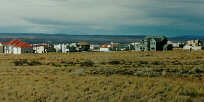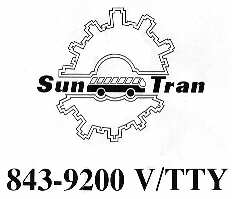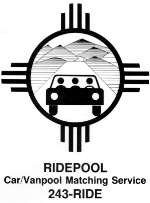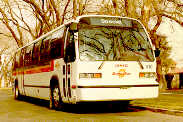
Two of the most serious problems that the Albuquerque area faces today are transportation issues: traffic congestion and air pollution. Since 1960, the local population has doubled, yet transportation capacity, in all of its forms, has not doubled. The result has been increasing traffic congestion. Traffic congestion creates problems because it lengthens and makes uncertain the amount of time required to drive from one place to another; creates extra pollution since cars stuck idling in heavy traffic pollute more than cars that are moving; causes more traffic accidents; and burdens drivers and their passengers with increased levels of stress.
Residents of Albuquerque cherish this area's wide open spaces. In recent years, more and more of these spaces have been developed for residential use. As the local population has increased, and as the need for affordable housing has become more acute, more people have chosen to live on the fringes of the city. Yet because the rapid growth on the fringes has been primarily residential, most of those residents must commute to jobs in more densely populated areas of the city. This necessity has not only added to the traffic congestion in the major employment centers (Kirtland Air Force Base, UNM, Uptown, Downtown, and the north I-25 industrial corridor), it has also lengthened the average daily trip, sending additional air pollutants into an already sensitive environment.
Solution of the city's two-pronged transportation problem consists of five components: moving traffic more efficiently on existing roads, building new roads, increasing mass transit ridership, expanding use of alternate forms of transportation such as carpooling and bicycling, and reducing the number of (or changing the timing of) work trips. Pursuing any one of these components individually will not solve the problem in the long term; each part must be carefully weighed and balanced with the others to create a solution that meets Albuquerque's transportation needs while taking into account local geography, values, and lifestyles.
Road building is the most commonly used method for improving transportation in an area. When they are not at full capacity, roads provide easy and direct movement between areas. But building another road is becoming an increasingly difficult way to provide greater transportation capacity. Albuquerque has some major natural barriers to road expansion--the Rio Grande, the Sandia Mountains, the western escarpment, and many arroyos. More important, unfettered road building can erode the quality of life in an area and ruin the livability of neighborhoods. Roadway noise, automobile emissions, and traffic diverting through side streets in search of a short-cut can quickly strip away the serenity of a neighborhood. While a basic level of roadway capacity is required in Albuquerque, building more roads is not always the best transportation solution.
Making efficient use of existing roads is easier today with a wide range of congestion management tools. Congestion management tools are designed to smooth traffic flow and reduce stop-and-go traffic. The tools can be as simple as synchronizing signals along a busy stretch of road to allow traffic to move at the posted speed with few stops. The tools can be as sophisticated as designating some freeway lanes as high-occupancy vehicle (HOV) lanes, for use only by mass transit and carpools during peak commuting periods or throughout the day. Ramp metering--using a traffic signal near the beginning of a freeway on-ramp--may be used to prevent cars from entering the freeway in bunches and causing the traffic to slow dramatically or stop. Albuquerque is working to improve traffic signal synchronization and continues to research other congestion management techniques for keeping traffic, particularly peak-hour traffic, moving smoothly.

Mass transit is a very effective method for moving large numbers of people quickly with few vehicles and reduced air pollution. Albuquerque currently has a mass transit service that includes buses for general ridership (Sun Tran) and by-reservation vans for those with impaired mobility (Sun Van). Mass transit is particularly useful in meeting the transportation needs of those who do not own cars, whether due to economic hardship, by choice, or because of physical limitations.
In an effort to expand the role and effectiveness of mass transit in Albuquerque, the city is now putting an emphasis on intermodal transportation. Intermodal transportation centers around mass transportation in all of its forms (light rail, heavy rail, city bus, and intercity bus), allowing connections between them and with other modes of transportation such as walking, bicycling, and driving. As part of the emphasis on intermodal transportation, the city is investigating possibilities for future light-rail development in Albuquerque. Additionally, more Park & Ride lots are being developed to meet the particular needs of commuters in outlying areas of the city. Park & Ride lots are becoming increasingly popular, allowing those who do not live near a bus stop to drive to a lot, park their car for free, and ride a bus to their destination.
Albuquerque's existing land development patterns in many ways hamper the efficiency of mass transit. Sprawling, low-density development increases the number of vehicles needed to serve an area with mass transportation. Neighborhoods with numerous cul-de-sacs and enclosed by high walls prevent pedestrians from walking short distances to a bus stop. All but private automobile use is dissuaded by wide streets lacking amenities such as safe crosswalks, shade trees, benches, and simply a pleasant atmosphere. Streets lined with large parking lots discourage transit trips to the stores located deep behind the parking lots. For mass transit to work effectively, land use and development must progress with the transit rider in mind.
 Use
of alternate forms of transportation is not new. Until the 1960s, many American
households owned one vehicle, and carpooled with neighbors to stretch that one
vehicle to meet every family member's trip needs. Today, carpooling is a cheap,
easy, and relatively popular commuting method. On the large scale, carpooling
reduces traffic congestion and air pollution, on the personal scale, it saves
money, time (in some cases), and stress. The city of Albuquerque Transit &
Parking Department administers RIDEPOOL, a free ride-matching service to the
community. RIDEPOOL participants can be matched with someone who has a similar
schedule, home address, and travel destination who can travel with them by carpool,
vanpool, or even bicycle. Carpooling is a very versatile tool for increasing
transportation capacity in the area.
Use
of alternate forms of transportation is not new. Until the 1960s, many American
households owned one vehicle, and carpooled with neighbors to stretch that one
vehicle to meet every family member's trip needs. Today, carpooling is a cheap,
easy, and relatively popular commuting method. On the large scale, carpooling
reduces traffic congestion and air pollution, on the personal scale, it saves
money, time (in some cases), and stress. The city of Albuquerque Transit &
Parking Department administers RIDEPOOL, a free ride-matching service to the
community. RIDEPOOL participants can be matched with someone who has a similar
schedule, home address, and travel destination who can travel with them by carpool,
vanpool, or even bicycle. Carpooling is a very versatile tool for increasing
transportation capacity in the area.
Other forms of alternate transportation that work well in the Albuquerque area are bicycling and walking. Because of the dry, relatively mild climate, walking or biking to work is feasible most days of the year. Bicycle commuting is most likely to occur when the travel distance is ten miles or less. Walking to work can be difficult in Albuquerque, since it is increasingly unlikely that one will live a mile or less from work. Walking, however, serves as a terrific link to other modes of transportation, such as riding the bus or carpooling. Of course, walking and bicycling to work are very healthful forms of transportation that give something back to the commuter.
The bicycle is a low-cost and effective means of transportation. It is quiet, non-polluting, and energy efficient. In the pre-automobile era, the bicycle was popular as a transportation mode in the United States. The bicycle geared to short trips lost its popularity with the mass production of the automobile, which gave people opportunities to live further from employment centers.
Today, local, State and Federal agencies are incorporating bikeways (i.e., bike lanes/routes and trails) into the existing transportation system as a means of providing travel choices. Bicycle studies have revealed that more people are willing to bicycle more frequently if better bikeways are provided that link destinations as such employment centers, schools, shopping centers, parks, and entertainment/recreational activity centers.
For the first time, the City of Albuquerque has taken a more comprehensive approach in meeting bicyclists needs for on-street bikeways. A Comprehensive Bike Plan is being prepared which will address reduction of automobile use and increase in bicycling. The goal of the plan is to significantly increase the bicycle commute mode share and reduce the number of bicycle fatalities and injuries by 2020.
To accomplish this task, the existing bikeway system was inventoried to determine which bike lanes/routes needed improvements. In addition, all collectors and arterials were inventoried to determine the feasibility of bike lanes and connections to destinations. The National Bicycling and Walking Study, Case Study 1 revealed that communities with more bike lanes on collectors and arterials would increase bicycling since these bikeways connect into destinations. (A collector is a street that funnels traffic from local/residential streets to the main thoroughfares, the arterials.) As the future bikeway system is developed, funding to implement both bike routes/ lanes needed to be identified. Currently, five percent of the local transportation funds are dedicated to on-street bikeways and off-street paths/trails. Additional funds are available from Federal transportation and air quality funds, which compete with other transportation construction, service, or enhancement projects. At the current funding level, it will take the City of Albuquerque a minimum of 40 years to complete its on-street bikeway system.
The trail network is an integral part of the bikeway system and can not be overlooked due to the numerous barriers within the metropolitan area such as rivers, interstates, drainage channels, and arroyos. Like the on-street bikeway system, the trail network serves both commuting and recreational travel. Many times on-street bikeway facilities are not viable, but development of a trail system that interconnects to the street system and vice versa provides access to and from destinations for bicyclists. This can be seen with the Paseo del Bosque Trail and the North Diversion Channel Trail that are primary north/south bikeways connecting the city. Approximately half of the identified primary trails proposed in the Bikeways Master Plan have been constructed. Other trails are identified in the Trails and Bikeways Facility Plan that interconnect both the primary trails and the on-street bikeway system. These trails can be paved or unpaved trails meeting the needs of equestrians, pedestrians and bicyclists. At historic funding levels, it is estimated to take approximately 10 years to complete the primary trail network not including major grade-separated crossings, which are very expensive.
While the provision of bikeways is an essential component to increase both commuting and recreational bicycling in the community, other elements are important. Other issues include bicycle connectivity to transit corridors and centers, park and ride lots, and on-site bicycle facilities. Efforts are underway to encourage developments to provide secure, short and/or long-term bicycle parking. In addition, showers/lockers are recommended during the commercial and recreational development proposals and in the City's work with existing and future employers.
 Reducing
the need for trips or changing their timing are other valuable tools for reducing
air pollution and freeing up roadway capacity. Telecommuting and condensed work
weeks allow employees to put in full work weeks, yet make fewer trips to the
office. Businesses using a four-day, ten-hour work week reduce their commuting
trips by twenty percent. Flexible work hours allow employees to travel at times
of the day when traffic congestion is lower, reducing the time they spend on
the road and the resulting auto emissions.
Reducing
the need for trips or changing their timing are other valuable tools for reducing
air pollution and freeing up roadway capacity. Telecommuting and condensed work
weeks allow employees to put in full work weeks, yet make fewer trips to the
office. Businesses using a four-day, ten-hour work week reduce their commuting
trips by twenty percent. Flexible work hours allow employees to travel at times
of the day when traffic congestion is lower, reducing the time they spend on
the road and the resulting auto emissions.
Reducing auto emissions and traffic congestion in Albuquerque requires a careful balancing and application of each transportation tool available. Thoughtfully applied, land use and development patterns can allow those tools to work as they were designed. No single mode of transportation meets the needs of every individual in the city; most would benefit from using a combination of the modes. By making all transportation modes available and as effective as possible, the city can block the one-two punch of air pollution and traffic congestion in the future.
(Up to Section V, Back to Solid Waste Management, On to Urban Design, Local Context))